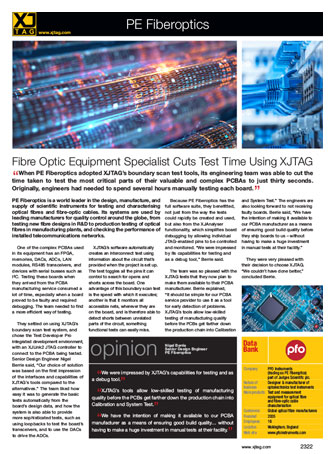When PE Fiberoptics adopted XJTAG’s boundary scan test tools, its engineering team was able to cut the time taken to test the most critical parts of their valuable and complex PCBAs to just thirty seconds. Originally, engineers had needed to spend several hours manually testing each board.
PE Fiberoptics is a world leader in the design, manufacture, and supply of scientific instruments for testing and characterising optical fibres and fibre-optic cables. Its systems are used by leading manufacturers for quality control around the globe, from testing new fibre designs in R&D to production testing of optical fibres in manufacturing plants, and checking the performance of installed telecommunications networks.
One of the complex PCBAs used in its equipment has an FPGA, memories, DACs, ADCs, LAN modules, RS485 transceivers, and devices with serial busses such as I2C. Testing these boards when they arrived from the PCBA manufacturing service consumed a lot of time, especially when a board proved to be faulty and required debugging. The team needed to find a more efficient way of testing.
They settled on using XJTAG’s boundary scan test system, and chose the Test Developer Pro integrated development environment, with an XJLink2 JTAG controller to connect to the PCBA being tested. Senior Design Engineer Nigel Berrie said, “Our choice of solution was based on the first impression of the interfaces and capabilities of XJTAG’s tools compared to the alternatives.” The team liked how easy it was to generate the basic tests automatically from the board’s design data, and how the system is also able to provide more sophisticated tests, such as using loopbacks to test the board’s transceivers, and to use the DACs to drive the ADCs.
XJTAG’s software automatically creates an interconnect test using information about the circuit that’s provided when the project is set up. The test toggles all the pins it can control to search for opens and shorts across the board. One advantage of this boundary scan test is the speed with which it executes; another is that it monitors all accessible nets, wherever they are on the board, and is therefore able to detect shorts between unrelated parts of the circuit, something functional tests can easily miss.
Because PE Fiberoptics has the full software suite, they benefitted, not just from the way the tests could rapidly be created and used, but also from the XJAnalyser functionality, which simplifies board debugging by allowing individual JTAG-enabled pins to be controlled and monitored. “We were impressed by its capabilities for testing and as a debug tool,” Berrie said.
The team was so pleased with the XJTAG tests that they now plan to make them available to their PCBA manufacturer. Berrie explained, “It should be simple for our PCBA service provider to use it as a tool for early detection of problems. XJTAG’s tools allow low-skilled testing of manufacturing quality before the PCBs get farther down the production chain into Calibration and System Test.” The engineers are also looking forward to not receiving faulty boards. Berrie said, “We have the intention of making it available to our PCBA manufacturer as a means of ensuring good build quality before they ship boards to us – without having to make a huge investment in manual tests at their facility.”
They were very pleased with their decision to choose XJTAG. “We couldn’t have done better,” concluded Berrie.







